What You Need to Know About Domain Squatting in 2025
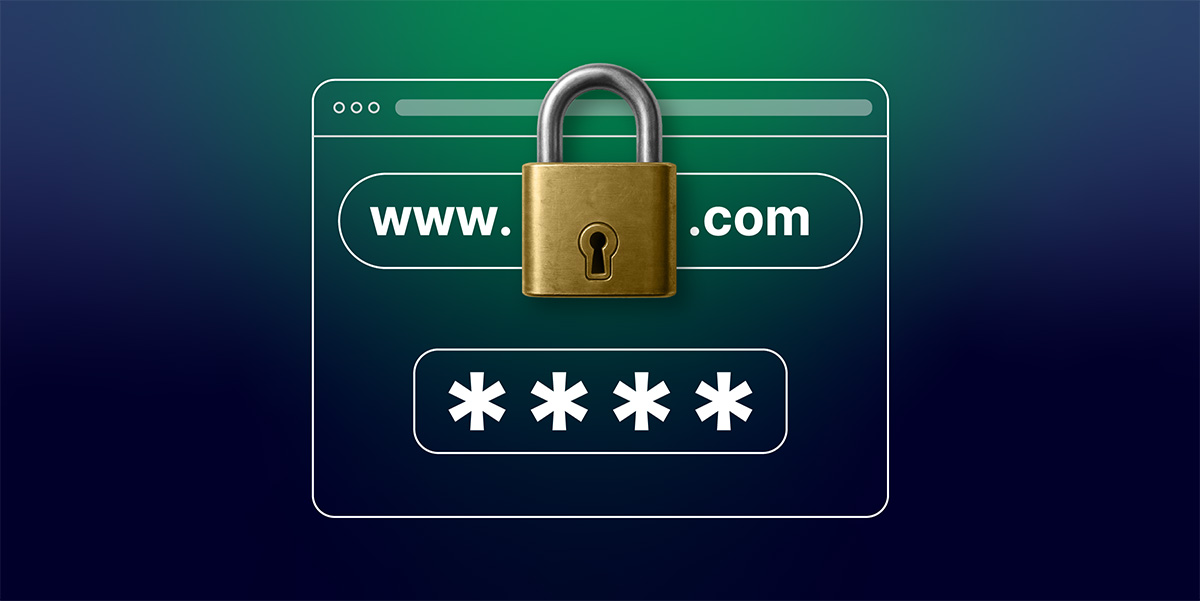
You’ve built your brand, brainstormed the perfect name, and checked if the domain is available—only to find out it’s already taken. Not by a legit business, but by someone who beat you to the punch…and now they’re asking thousands just to hand it over. Welcome to the frustrating world of domain squatting.
In 2025, domain squatters have gotten smarter and faster. But so has the know-how when it comes to fighting back. Indeed, when businesses understand how domain squatting works, it makes it a whole lot easier to avoid falling victim to the practice.
This guide breaks it all down given the state of domain squatting in 2025: what domain squatting actually is (and isn’t), the smart steps you can take right now to protect your business, and how you can take action if necessary. Let’s get into it.
What is Domain Squatting?
Domain squatting, or cybersquatting, happens when someone registers a domain name that closely resembles an existing brand, trademark, or business—not to build something real, but to cash in on someone else’s reputation. These individuals often sit on the domain, waiting to sell it back at a steep price or use it to divert web traffic. It’s frustrating for businesses trying to protect their brand, and in many cases, it’s illegal.
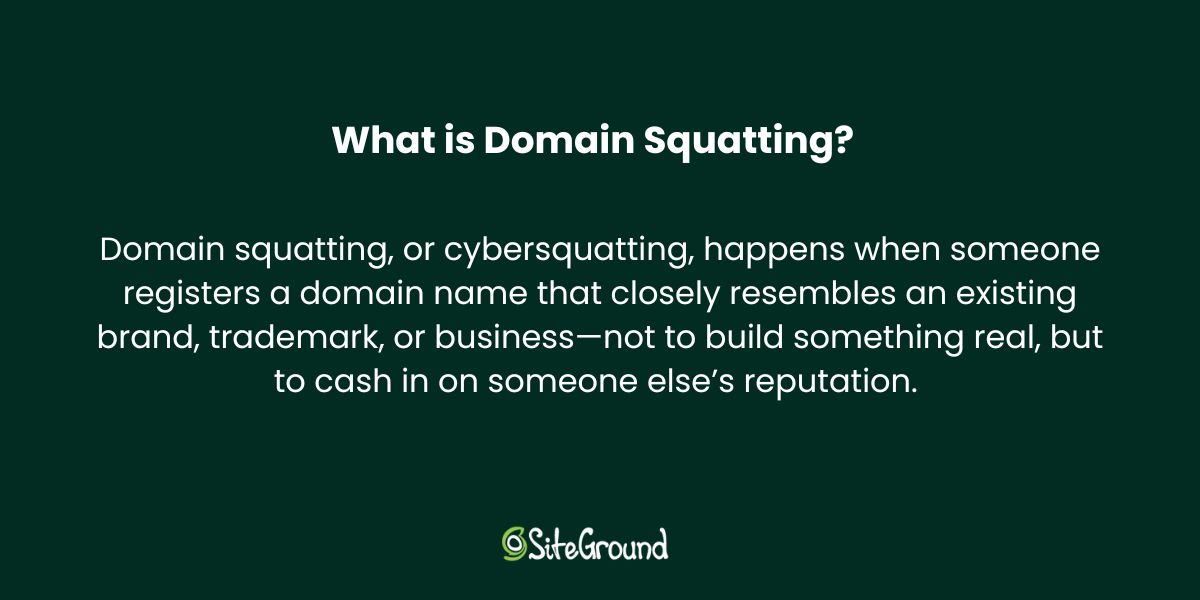
What Domain Squatting Isn’t
Not every domain conflict is a case of squatting. Domain squatting requires bad-faith intent—like registering a domain just to profit from someone else’s trademark or mislead users. But there are plenty of legitimate reasons someone might own a domain you want. For example, someone may have registered the domain for a personal project or business with the same name, bought it as a generic investment (also known as domaining, which we’ll touch on in a moment), or owned it long before your brand even existed.
If there’s no intent to deceive, extort, or capitalize unfairly on your trademark, it’s not domain squatting—it’s just an unfortunate overlap. Understanding this distinction is key before you take action.
Domain Squatting vs. Domaining
While they might sound similar, domain squatting and domaining are very different practices. Domain squatting involves registering domain names that match someone else’s trademark, and with the bad-faith intent to profit from it later. It’s generally illegal and can lead to lawsuits or forced domain transfers.
Domaining, on the other hand, is a legitimate business. Domainers buy and sell domain names that are generic and brandable (like bestshoes.com or glimmer.io), and without targeting specific trademarks. It’s like digital real estate investing: profitable, legal, and often helpful for startups looking to acquire a relevant, available name.
The key difference lies in the intent and trademark infringement. If a domain is registered to hijack or hold hostage someone else’s brand, it’s squatting. If it’s about spotting valuable opportunities in unused domain names, it’s domaining.
How Domain Squatting Can Impact Your Business
Domain squatting can seriously derail your brand, especially if you’re a startup or creator building your online presence.
It disrupts your ability to establish a consistent identity, confuses customers, and can hurt your credibility. Worse, squatters often demand high payouts for the domain, or force you into expensive, time-consuming legal battles, draining resources you’d rather invest in growth.
Simply put, domain squatting can stall your brand before it even has a chance to thrive. So let’s nip this one in the bud before it becomes a bigger problem.
How to Avoid Domain Squatting
When it comes to domain squatting, starting your prevention measures early is the best way to save you from major headaches later on. So let’s begin at the earliest phases, because this is where you can make the smartest moves.
Step 1: Secure Your Brand Identity Early
Building a strong brand starts with securing your identity — and that means locking down the name you want before someone else does. Here’s how:
Choose a Distinctive Name
Great brand names are memorable, easy to pronounce, and hard to confuse with others. Steer clear of generic or overly descriptive names that competitors can easily mimic. The more unique your business and website name, the easier it is to protect.
Check Trademark Availability
Before falling in love with a name, check if it’s already trademarked. A quick search through the USPTO (United States Patent and Trade Organization) or your country’s trademark registry can save you from costly legal headaches later.
Register Your Trademark (When You’re Ready)
Trademarking offers strong legal protection but can take time and money. If you’re not ready to file yet, consider registering a DBA (“Doing Business As”) in your state or municipality. It’s a practical first step that gives you some rights while you grow.
Step 2: Lock Down Key Domains
Once you’ve got your brand name locked in, the next step is to make sure no one else can claim your digital turf. Securing the right domains isn’t just an important part of website planning—it’s about covering all your bases to keep domain squatters at bay.
Buy Your Primary Domain
Your primary domain—the one that matches your brand name exactly—is your online home base. Once you choose a domain name, snag it as soon as possible, ideally with a .com extension, since it’s still the most recognized and trusted by customers worldwide. And don’t wait around hoping it’ll be available later; once it’s gone, it’s often gone for good. You can secure your perfect name today easily and confidently by registering your domain via SiteGround.
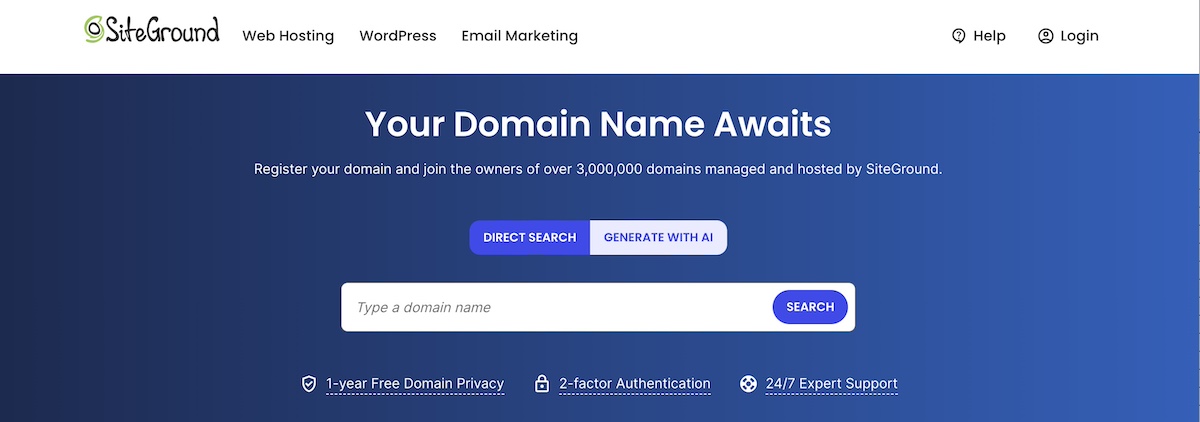
Register Common Misspellings and Variations
You have a domain name, but now what? People make typos—it’s inevitable. To prevent potential visitors from landing on a squatter’s site or a competitor, register common misspellings, plural forms, and slight variations of your domain. These small investments can save you from problems and lost traffic down the road.
Consider Multiple TLDs
The domain world has expanded way beyond .com, with plenty of new top-level domains (TLDs, also called domain extensions) like .net, .co, .biz, or industry-specific options like .tech or .store. Depending on your budget and brand strategy, it’s wise to register your name across several relevant domain extensions. This doesn’t just block squatters, it also gives you flexibility for future growth or marketing campaigns.
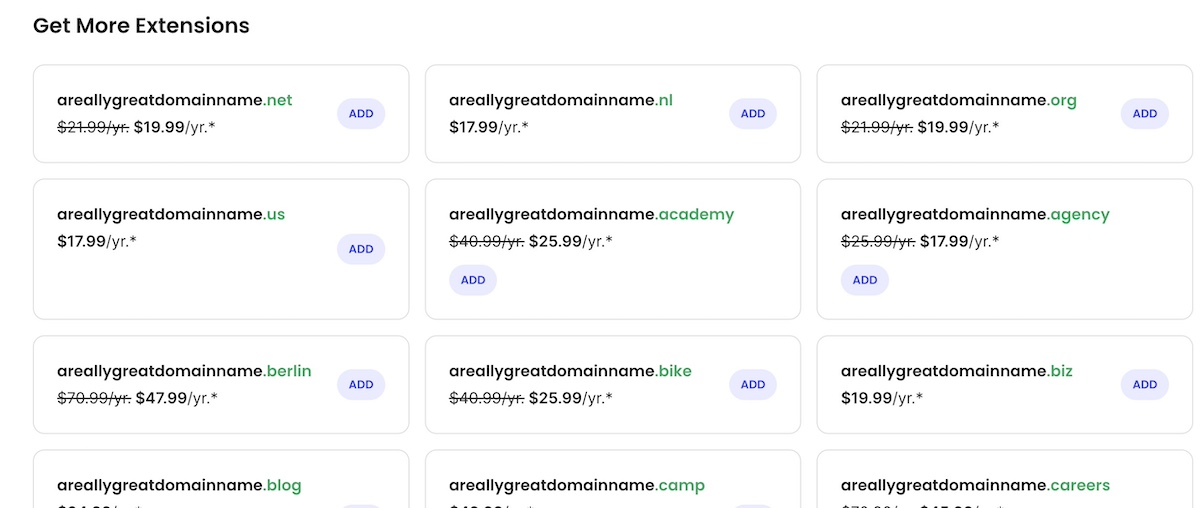
Locking down these variations and top-level domains early gives you control over your brand’s online presence and makes it much harder for domain squatters to catch you off guard.
Step 3: Claim Your Name on Social Media
Just like domain squatting, social media handle squatting is a sneaky tactic where someone grabs your brand’s name on social platforms—not to generously build your presence, but to block you or profit off your success. As part of your social media marketing strategy, securing consistent handles across major platforms can easily be just as important as locking down your domain name. It helps you keep your brand identity tight and trusted everywhere online.
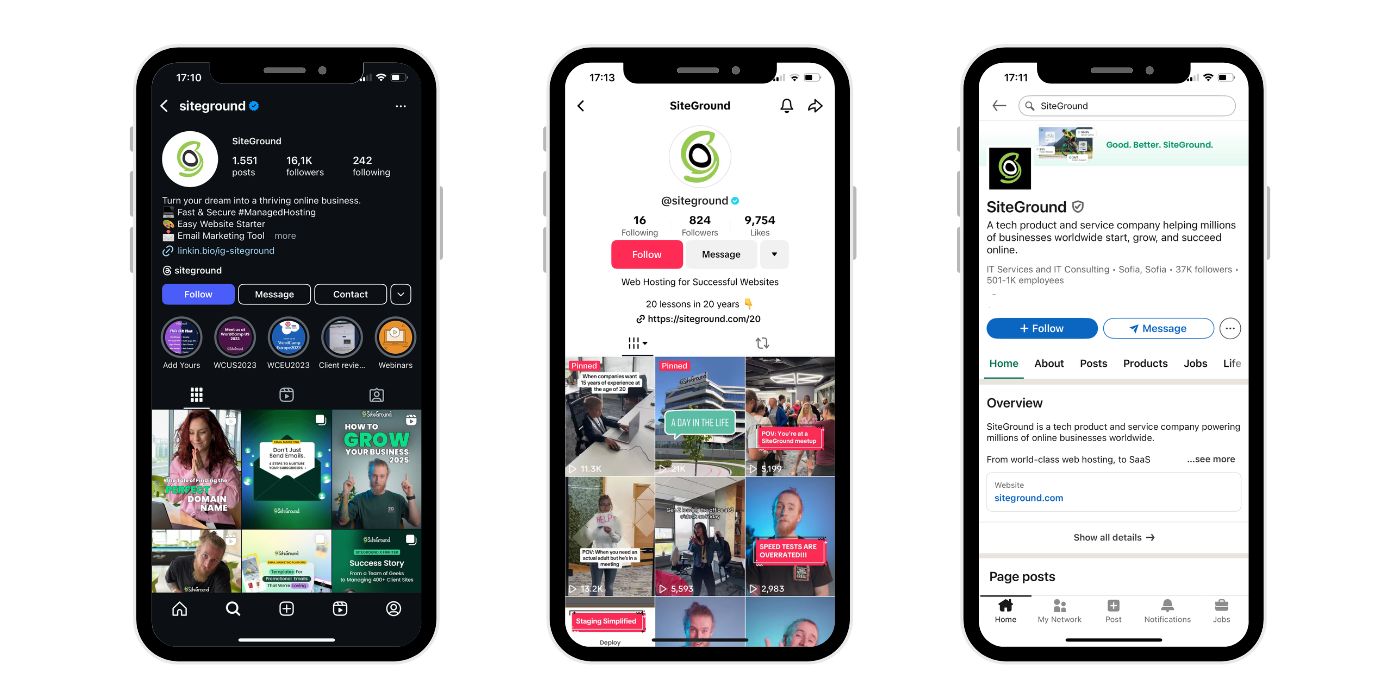
Step 4: Set Up Monitoring Alerts
Even after securing your domains and social handles, staying vigilant is still a good plan. Domain squatters and impersonators can strike anytime, so setting up monitoring alerts helps you catch problems early, before they turn into those big headaches.
Use Domain Monitoring Services
There are specialized services that keep an eye on new domain registrations that resemble your brand name. These tools alert you if someone registers a suspicious domain, giving you a chance to act quickly—whether that means reaching out to the owner or preparing to take legal steps.
Set Up Google Alerts for Your Brand Name
Google Alerts is a free, easy way to stay informed about mentions of your brand online. Set alerts for your brand name, common misspellings, and related keywords. This way, you’ll be notified if someone is using your name in unexpected places, helping you spot social media squatting, fake accounts, or even negative publicity fast.

Monitoring alerts are your early warning system, as it helps you defend your brand from domain squatting and online impersonation before they do any real damage.
Step 5: Work with a Reputable Domain Registrar
When it comes to domain name registration, choosing where you register is just as important as what you register. A trusted, well-established domain registrar—such as SiteGround, for example—offers tools and safeguards that can help prevent domain hijacking and squatting risks down the line. Let’s examine.
Enable Domain Privacy
When you register a domain, your personal details (like name, email, and phone number) are often listed in the public WHOIS database—unless you opt for domain privacy protection via your registrar. This feature masks your information, helping protect you from spammers, scammers, and opportunistic squatters who monitor registrations to target new businesses.
Use Domain Locking for Extra Security
Most reputable registrars also offer domain locking, which prevents unauthorized transfers of your domain name. It’s a simple but powerful way to stop someone from trying to hijack your domain without your permission.
Set Up Two-Factor Authentication
Once you’ve secured your domain, protect your account by enabling two-factor authentication. This adds an extra layer of security beyond just a password, helping prevent unauthorized access to your domain registrar account and reducing the risk of hijacking or theft.
Always-Available Customer Support
Dealing with domain issues like squatting can be tricky and stressful. Having knowledgeable support available 24/7 means you’re never alone when navigating these challenges. Whether you need help securing your domain or resolving disputes, expert assistance ensures you get the right guidance quickly, keeping your brand protected and your site running smoothly.
SiteGround offers all of the above: from two-factor authentication and domain locking to expert support and even free domain privacy for the first year. It’s a secure, reliable choice that helps protect your online identity from day one. Even better? SiteGround is an all-in-one platform for everything your business needs to grow online—domain registration, hosting, easy site-building tools, and professional email marketing—all backed by top-rated customer support.
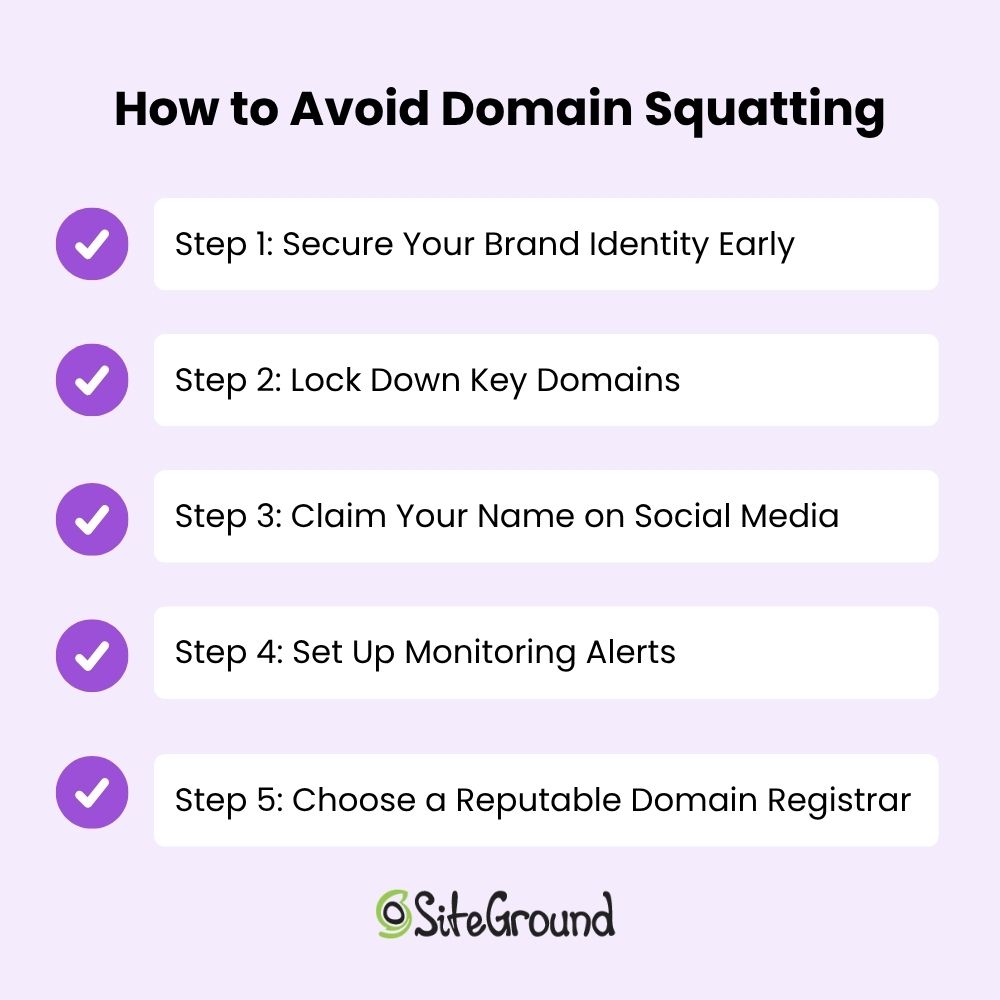
What to Do If Your Desired Domain Is Squatted On
If your ideal domain is already taken, don’t panic—there are smart, practical steps you can take to understand if and how to make your next move. Whether it’s a case of domain squatting or simply a name that’s already in use, you still have options.
Step 1: Investigate the Current Owner
Find out who owns the domain
Use WHOIS lookup tools to access public registration details like the owner’s name, contact info, and registration date. This data can help you determine whether the owner is an individual, a business, or possibly a domain squatter.
Check the domain’s history
Use tools like the Wayback Machine to see how the domain was used in the past—whether it was active, abandoned, or linked to questionable content. Knowing its history can help you decide if pursuing the domain is worth it or if you should explore other options, and it can also inform your approach if you need to contact the current owner.
Step 2: Determine If It’s a Case of Squatting
Not every taken domain is a case of squatting—sometimes it’s just a coincidence (we’ll explore some examples in a moment). But if someone’s sitting on your brand name without a legitimate reason, it may cross into squatter territory. How do you know?
Look for trademark infringement
If you’ve registered your trademark (or even if you have strong common law rights), and someone is using the domain in a way that could confuse customers or damage your brand, that’s a red flag.
Assess the owner’s intent and use
Is the domain just parked with ads or for sale at an inflated price? Is the site mimicking your business or redirecting traffic elsewhere? If the owner has no legitimate interest in the name and seems to be holding it hostage, you might be dealing with a classic case of domain squatting.
Step 3: Consider Your Options
Once you’ve confirmed that your desired domain is taken—and possibly being squatted—you have a few paths forward. The right choice depends on your budget, timeline, and how aggressively you want to pursue the name.
Negotiate a Purchase
Sometimes the simplest solution is reaching out to the owner with a reasonable offer. Use a domain broker if you’d prefer to stay anonymous or want help navigating the negotiation. Be prepared for counteroffers—especially if the domain matches a trending term or business name.
File a Complaint (UDRP or URS)
If the domain clearly violates your trademark rights and was registered in bad faith, you may be able to file a formal dispute with ICANN under the Uniform Domain-Name Dispute-Resolution Policy (UDRP) or the faster Uniform Rapid Suspension (URS) system. These administrative procedures are typically quicker and less expensive than going to court, but they require clear evidence that: you hold trademark rights to the name, the current registrant has no legitimate interest in it, and the domain was registered and used in bad faith. For more details on how to initiate these disputes, you can visit the WIPO Domain Name Dispute Resolution Center, which administers many of these cases internationally.
Pursue Legal Action
In serious cases, especially where damages are involved, legal action might be necessary. The Anticybersquatting Consumer Protection Act (ACPA) is a law in the U.S., for example, that gives trademark holders a way to sue domain squatters in court. It’s the most involved route, but sometimes the most effective.
Noteworthy Domain Squatting Dispute Examples
Domain squatting doesn’t just impact small businesses on a budget—it hits major brands, celebrities, and startups alike. And not surprisingly: because that’s where the domain squatting jackpot is at. Here are a few entertaining and headline-worthy examples that show the nuances of domain squatting, and the outcomes.
1. Nissan.com
One of the most cited examples—though often misunderstood. In the late 1990s, Uzi Nissan, a computer repair shop owner, registered nissan.com for his legitimate business, long before Nissan Motor Corporation pursued the domain. Despite years of legal pressure from the automaker, Uzi Nissan held on to the domain because it was, quite literally, his name. This wasn’t a textbook case of domain squatting, since there was no bad-faith intent to profit off the brand. But it highlights how valuable domain names can become—and why businesses should secure theirs early.
2. Madonna.com
In the early 2000s, pop icon Madonna filed a successful complaint under the UDRP to reclaim madonna.com from an individual who had filled the site with adult content. The panel of course found clear evidence of bad faith and awarded her the domain.
3. MikeRoweSoft.com
In one of the more playful domain disputes, a Canadian high school student named Mike Rowe registered mikerowesoft.com for his part-time website design business. The name was a pun—“Mike Rowe Soft”—but it phonetically resembled Microsoft, and the tech giant took issue. While it looked like a case of cybersquatting on the surface, Mike’s intent wasn’t malicious or deceptive, just clever wordplay. After some public backlash and media attention, Microsoft softened its stance and reached a friendly resolution—complete with an Xbox for Mike.
4. Tesla.com
Before Tesla became a household name, tesla.com was registered by Silicon Valley engineer Stuart Grossman, who had held the domain since the 1990s. Unlike a typical squatter, Grossman wasn’t trying to sell the domain for profit or capitalize on the Tesla brand—he simply had a long-standing personal interest in Nikola Tesla. For years, Tesla Motors operated under teslamotors.com while reportedly trying (and failing) to negotiate a deal. Eventually, in 2016, the company acquired tesla.com—but only after what Elon Musk described as years of “painful” back-and-forth. Though not a squatting case per se, it’s a cautionary tale about how hard (and expensive) it can be to get the perfect domain after your brand takes off.
5. Airbnb.ca
When Airbnb expanded into Canada, they discovered that airbnb.ca was already registered—not by the company, but by a domain investor who had set up a generic travel-related website. While it wasn’t outright impersonation, Airbnb argued that the registrant was capitalizing on their growing brand recognition in bad faith. They filed a UDRP complaint, citing trademark infringement and lack of legitimate interest by the domain holder. Ultimately, the panel sided with Airbnb, and the company regained control of the domain.
These examples show that domain squatting affects everyone—from garage startups to global icons. Learn from their mistakes: don’t wait to secure your brand’s domain and trademarks, because once your business takes off, the stakes (and the price tags) only get higher.
Protecting Your Brand from Domain Squatting: The Bottom Line
By now, you’re surely convinced: you need to jump on that prized domain name, and you need to do it now. Because it’s at the heart of your online identity, and a key piece of your long-term success. Choosing the right name takes a mix of creativity, strategy, and a little bit of legal know-how. So the earlier you secure it, the better positioned you’ll be to grow with confidence.
When you’re ready to claim your domain, build your website, and get it online fast, SiteGround makes it easy. From domain registration to reliable hosting and intuitive website tools, we’ve got everything you need to get started and stand out.




Comments ( 0 )
Thanks! Your comment will be held for moderation and will be shortly published, if it is related to this blog article. Comments for support inquiries or issues will not be published, if you have such please report it through our official channels of communication.
Leave a comment
Thanks! Your comment will be held for moderation and will be shortly published, if it is related to this blog article. Comments for support inquiries or issues will not be published, if you have such please report it through our official channels of communication.